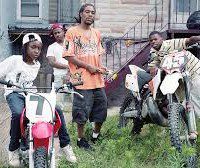The documentary 12 O’Clock Boys could only be made in Baltimore, a small city that punches above its weight on the American arts scene. Filmmakers like Matthew Porterfield (Putty Hill, Hamilton), and musicians like Dan Deacon and Beach House, have recently emerged at the forefront of their respective arts, reinvigorating the cultural community that gave us Barry Levinson, Anne Tyler, and Charles S. Dutton. Looming above this creative landscape, offering both an inspiration and a challenge, is the monumental achievement of The Wire, David Simon’s HBO series on the life and death of a great American city.
12 O’Clock Boys is a film that stands up to its inevitable comparisons with Simon’s urban epic. Director Lofty Nathan trains his lens on the dirtbike gangs that roam the same impoverished neighborhoods in which much of The Wire took place. With its lyrical scenes of inner city life and its nerve-wracking police chases, 12 O’Clock Boys achieves the same mixture of social observation and suspense-laden spectacle that made the series such exhilarating—and addictive—entertainment. To the uninitiated, the film might even be described as “The Wire, but real, plus dirt-bikes!”
But 12 O’Clock Boys succeeds on its own—much more intimate—terms, offering one of the most richly textured coming-of-age stories in recent memory. The film’s protagonist, Pug, is a young boy with a single goal: to join the 12 O’Clock Boys, a gang of illegal dirt bikers whose raucous exploits are revered by his Westside peers. Pug’s obsession has his mother Coco at a loss—she’s trying her best to tame her child while dealing with the loss of his older brother—and places him on the wrong side of the law. After spending three years on Pug’s trail and shooting nearly 250 hours of footage, Nathan has crafted a strikingly beautiful portrait of a boy caught between home and ‘hood, childhood and adolescence.
To Pug and his friends, a dirt bike is a vehicle for inclusion and freedom. Nathan evokes these sensations with poetic precision, juxtaposing the comforting familiarity of life at home with the siren call of the roaring engines. When he’s filming Pug and Coco within the cramped confines of their row-house, the hand-held images are intimate but fluid, wonderfully responsive to the evolution of an emotion or a train of thought. When he’s filming the dirt bike rallies where the 12 O’Clock Boys gather each Sunday, he slows down the images of pimped-out choppers and synchronized wheelies, savoring every ray of sunlight that strikes the upturned wheels. With their bombastic music and their physics-defying stunts, the rally scenes have the rich pageantry of the dance-offs in Rize, David LaChappelle’s 2005 documentary about an L.A. dance crew.
But where Rize felt like a krumping infomercial in magenta hotpants, 12 O’Clock Boys grounds its study of urban dirt biking in the rhythms, the rituals, and the messy emotions of Pug’s daily experience. When Pug’s dirtbike is stolen near the end of the film, it’s a sobering reminder of the dog-eat-dog, fend-for-yourself society that his mother has tried—and inevitably failed—to protect him from. And for all the rebellious grandeur of the film’s rally sequences, they also convey the fragility of the lives perched atop the handlebars. As the 12 O’Clock Boys weave through traffic at excessive speeds, their behavior grows increasingly reckless, endangering the lives of bystanders, policemen, and fellow riders. Nathan reveals both the creative possibilities of life behind the wheel and the destructive fury of Pug’s impoverished peers.
The film is less detached, less scrupulously even-handed, in its depiction of Pug. As Pug runs through the street during a tense confrontation with the police, you can hear Nathan yelling at him from behind the camera, imploring the boy to get off the road. In the film’s final sequence, where Pug makes a daring bid to recover his stolen bike, Nathan seems as much Pug’s conspirator as his observer, spiriting the boy and his ride into a conveniently placed getaway van. Nathan’s decision to sacrifice reportorial objectivity, and develop close relationships with the people onscreen, turns out be one of the film’s greatest strengths. Pug’s childhood experiences are rendered with an immediacy, and a spontaneity, that could only result from the hard-won intimacy he’s established with the boy and his family. Over the course of the film, we watch Pug develop into a personality as vibrant and distinctive as his name, a Huckleberry Finn of the Mid-Atlantic Ghetto.
12 O’Clock Boys is the latest in a long line of great documentaries about the creative subcultures on the margins of American society. Like Hoop Dreams and Paris is Burning before it, the film reminds us that people outside the country’s cultural mainstream are often the hardiest, most intrepid standard-bearers for its folk traditions. On the local talk radio stations, the 12 O’Clock Boys are disparaged as lawbreakers and thugs, but the film reveals the civic pride and dogged work ethic that sustains their weekly rallies. What could be more American, Nathan asks, than a boy crouched over an engine, wrench in hand, working on his ride? Like the exhilarating film in which he stars, and the resilient city where he draws his breath, Pug is an exuberant vision of American endeavor.





One response
F*ck yes! I can’t wait to watch it. I still ride, and I used to ride dirt bikes when I was a juvenile delinquent. Hooray for the riders in this film! It will be difficult to watch teenagers engage in dangerous behavior, though! That never gets easy, no matter how old I am. I thank baby jesus every day that my child made it to adulthood intact!
Click here to subscribe today and leave your comment.